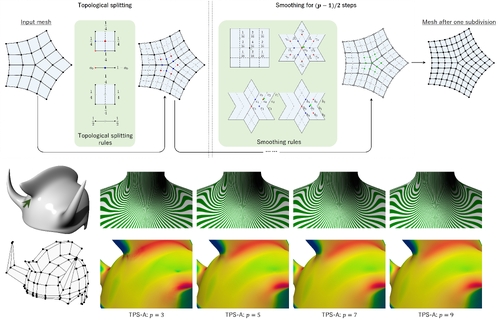A class of new tuned primal subdivision schemes with high-quality limit surface in extraordinary regions

DescriptionWe propose a unified tuning framework for primal subdivision schemes that are generalizations of odd-degree uniform B-spline surfaces for unstructured quadrilateral meshes of arbitrary topology. The subdivision of the resulting tuned primal subdivision (TPS) schemes is performed through efficient repeated local refinement operations. One level of subdivision of TPS-schemes is decomposed into one step of simple topological splitting plus an additional series of repeated local smoothing operations. The unified tuning framework optimizes subdivision rules for both topological splitting and smoothing operations near extraordinary vertices by minimizing the curvature fluctuation of the second-order characteristic maps of the respective TPS-scheme. To validate the limit surface quality of TPS-schemes in extraordinary regions, a mesh-independent metric is also devised to estimate local curvature variation in addition to highlight lines and direct curvature evaluation. With $(p-1)/2$ steps of smoothing operations in each level of subdivision, the respective TPS-scheme is termed as a degree-$p$ scheme that produces global $C^{p-1}$ limit surfaces everywhere except at a finite number of extraordinary positions where near-$G^2$ continuity is achieved. The limit surface of TPS-schemes in extraordinary regions also exhibits appealing highlight lines, and the larger the number of smoothing operations applied in each level of subdivision, the better the final limit surface quality. One of the key advantages of the proposed tuning framework for TPS-schemes is that the optimization of relevant subdivision rules is performed by tuning structured operations of topological splitting and repeated smoothing that involve direct neighbors of an extraordinary vertex only without the need of tuning large subdivision stencils. All subdivision operations of TPS-schemes are local, involving one-ring of neighboring vertices only, which is efficient for high-degree surface subdivision and convenient for practical implementation. Numerical examples also validate the superiority of TPS-schemes over other state-of-the-art subdivision methods in terms of both highlight lines and various curvature measures.
Event Type
Technical Papers
TimeTuesday, 3 December 20249:00am - 12:00pm JST
LocationHall C, C Block, Level 4







